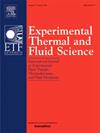Experimental study on the effectiveness of plasma energy deposition in controlling transverse jet
IF 2.8
2区 工程技术
Q2 ENGINEERING, MECHANICAL
Experimental Thermal and Fluid Science
Pub Date : 2025-01-21
DOI:10.1016/j.expthermflusci.2025.111420
引用次数: 0
Abstract
In this paper, we carried out an experimental study on the control of transverse jet via plasma energy deposition in a Mach 2.5 wind tunnel. The actuator operates at a discharge frequency of 10 kHz, generating thermal block effects upstream of the jet. Time-resolved schlieren system with 50 kHz shooting frequency, as well as wall static pressure taps, was utilized to measure the dynamic flow with and without excitation. This research delves into the feasibility of plasma energy deposition on controlling the transverse jets with varying injection total pressure (0, 200, 300, 400 kPa). The pressure increment within cavity resulting from discharge exists in all cases, attributed to the combined effects of plasma-induced shock and jet entrainment. Instantaneous schlieren images and the statistical analysis of their datasets were employed to investigate the unsteady characteristics of the flow field. The results indicate that discharge significantly elevates the energy contribution of unsteady modes, inhibits the low-frequency oscillations of the bow shock, and modulates the dominant frequency of the jet vortex shedding mode. Moreover, the increase in jet vorticity can be ascribed to the deformation of the precursor shock and the Richtmyer–Meshkov instability around thermal bubble/bow shock interaction region. As injection total pressure increases, the triangular-like region formed by the large eddy-induced shock, reflected shock, and the jet moves upstream and shrinks, consequently curtailing the region where jet pulsations amplify. After passing through bow shock, the effect of precursor shock on regulating the flow dampens with increasing injection total pressure. However, even at an injection total pressure of 400 kPa, coherent structures downstream of the bow shock can still be detected, demonstrating the broad control range of plasma energy deposition.
求助全文
约1分钟内获得全文
求助全文
来源期刊

Experimental Thermal and Fluid Science
工程技术-工程:机械
CiteScore
6.70
自引率
3.10%
发文量
159
审稿时长
34 days
期刊介绍:
Experimental Thermal and Fluid Science provides a forum for research emphasizing experimental work that enhances fundamental understanding of heat transfer, thermodynamics, and fluid mechanics. In addition to the principal areas of research, the journal covers research results in related fields, including combined heat and mass transfer, flows with phase transition, micro- and nano-scale systems, multiphase flow, combustion, radiative transfer, porous media, cryogenics, turbulence, and novel experimental techniques.
 求助内容:
求助内容: 应助结果提醒方式:
应助结果提醒方式:


